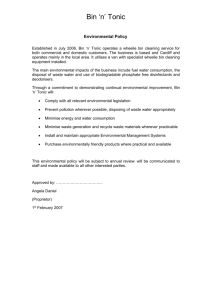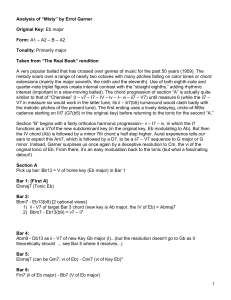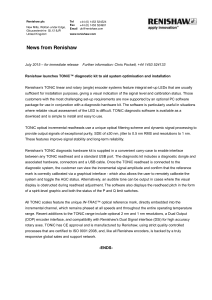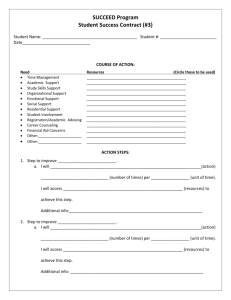MUSIC THEORY GAME HELP SHEET ACCIDENTAL: a sharp, flat or
advertisement
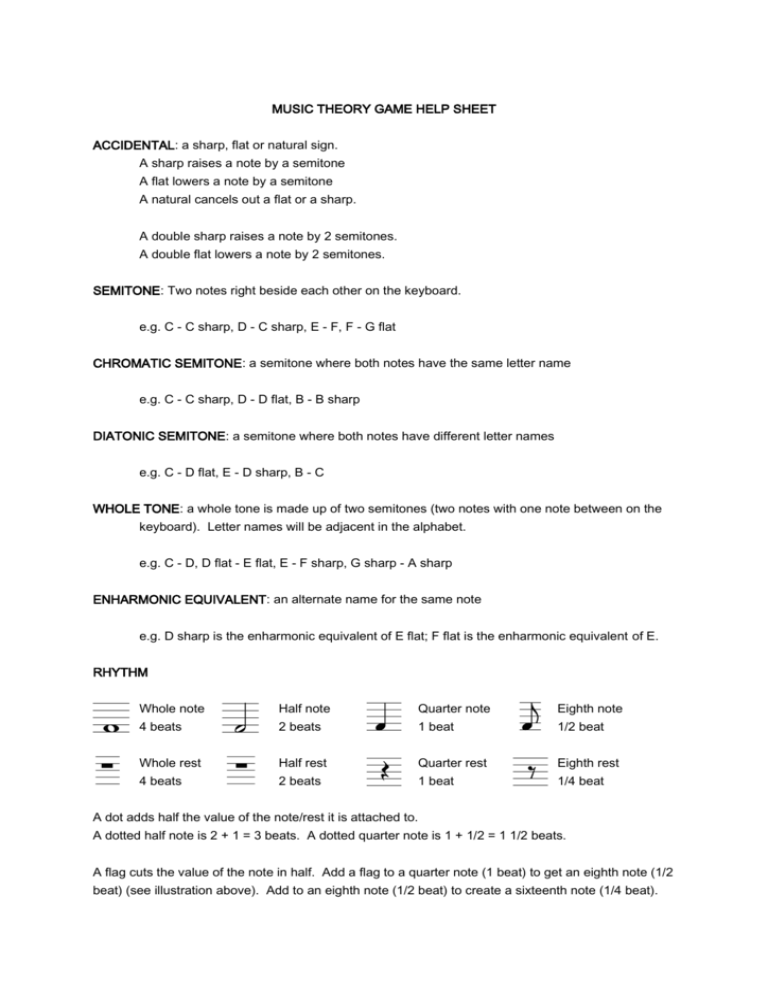
MUSIC THEORY GAME HELP SHEET ACCIDENTAL: a sharp, flat or natural sign. A sharp raises a note by a semitone A flat lowers a note by a semitone A natural cancels out a flat or a sharp. A double sharp raises a note by 2 semitones. A double flat lowers a note by 2 semitones. SEMITONE: Two notes right beside each other on the keyboard. e.g. C - C sharp, D - C sharp, E - F, F - G flat CHROMATIC SEMITONE: a semitone where both notes have the same letter name e.g. C - C sharp, D - D flat, B - B sharp DIATONIC SEMITONE: a semitone where both notes have different letter names e.g. C - D flat, E - D sharp, B - C WHOLE TONE: a whole tone is made up of two semitones (two notes with one note between on the keyboard). Letter names will be adjacent in the alphabet. e.g. C - D, D flat - E flat, E - F sharp, G sharp - A sharp ENHARMONIC EQUIVALENT: an alternate name for the same note e.g. D sharp is the enharmonic equivalent of E flat; F flat is the enharmonic equivalent of E. RHYTHM Whole note Half note Quarter note Eighth note 4 beats 2 beats 1 beat 1/2 beat Whole rest Half rest Quarter rest Eighth rest 4 beats 2 beats 1 beat 1/4 beat A dot adds half the value of the note/rest it is attached to. A dotted half note is 2 + 1 = 3 beats. A dotted quarter note is 1 + 1/2 = 1 1/2 beats. A flag cuts the value of the note in half. Add a flag to a quarter note (1 beat) to get an eighth note (1/2 beat) (see illustration above). Add to an eighth note (1/2 beat) to create a sixteenth note (1/4 beat). A double dot adds half the value of the first dot to the length of the note. A double dotted half note = 2 (half note) + 1 (first dot) + 1/2 (second dot) = 3.5 beats A whole rest can be used to indicate an entire bar of silence in any time signature except 4/2. A breve rest is a double whole rest, and is worth 8 counts (used in the 4/2 time signature). A triplet takes the place of 2 notes of the same value. e.g. A half note triplet replaces 2 half notes. A quadruplet takes the place of 3 of the same note value in compound time signatures. A quintuplet takes the place of 4 of the same note value in simple time signatures. In compound time signatures, it takes the place of 3 or 6 of the same note value. A sextuplet takes the place of 4 of the same note value in simple time signatures. A septuplet takes the place of 4 of the same note value in simple time or 3 in compound time. TIME SIGNATURES This time signature indicates that there are 2 half notes in each bar (2 x 1/2). (The notes of each bar will add up to the same number of counts as those 2 half notes.) This time signature is “cut time” and is another way to write 2/2. This time signature indicates that there are 3 quarter notes in each bar (3 x 1/4). (The notes of each bar will add up to the same number of counts as those 3 quarter notes.) This time signature indicates that there are 3 eighth notes in each bar (3 x 1/8). (The notes of each bar will add up to the same number of counts as those 3 eighth notes.) This time signature is “common time” and indicates 4 quarter notes in each bar. (The notes of each bar will add up to the same number of counts as those 4 quarter notes.) This time signature is “common time” and is another way to write 4/4. SCALES Key Signatures Related Keys Related keys have the same key signature. For example, C major and A minor are related because they share the same key signature (no sharps/flats). Tonic Major/Minor The tonic major and minor have the same name/same tonic note. For example, C major is the tonic major of C minor (same starting note). Scale Degrees Each note of the scale has a technical name. 1 - tonic 2 - supertonic 3 - mediant 4 - subdominant 5 - dominant 6 - submediant 7 - leading tone 8 - tonic WHOLE TONE SCALE A whole tone scale is made up entirely of whole tones. For example: C D E F# G# A# C MAJOR PENTATONIC The major pentatonic scale is the same as the corresponding major scale without notes 4 & 7. e.g. C major pentatonic: C D E G A C MINOR PENTATONIC The minor pentatonic scale is the same as the corresponding natural minor scale without notes 2 & 6. e.g. C minor pentatonic: C E flat F G B flat C BLUES Based on the major scale, the notes of the blues scale are as follows: Tonic, Flattened 3, 4, Flattened 5, Regular 5, Flattened 7, Tonic e.g. C blues – C, E flat, F, G flat, G natural, B flat, C OCTATONIC The octatonic scale alternates tones and semitones. Make sure to spell the tonic note the same way. e.g. F octatonic: F, G, A flat, B flat, B natural, C sharp, D, E, F B octatonic: B, C, D, E flat, F, F sharp, G sharp, A, B MODES IONIAN - another name for the major scale DORIAN - uses note 2 of the major scale as its tonic PHRYGIAN - uses note 3 of the major scale as its tonic LYDIAN - uses note 4 of the major scale as its tonic MIXOLYDIAN - uses note 5 of the major scales as its tonic AEOLIAN - another name for the natural minor; note 6 of the major scale is its tonic LOCRIAN - uses note 7 of the major scale as its tonic e.g. Scale has no sharps/flats (C major), tonic is D (note 2) - D Dorian Scale has no sharps/flats (C major), tonic is E (note 3) - E Phrygian Scale has no sharps/flats (C major), tonic is F (note 4) - F Lydian Scale has no sharps/ INTERVALS An interval is the space between two notes. To determine the size of the interval, count from the BOTTOM note to the top note. E.g. From C to D is a 2nd (C = 1, D = 2). From C to G is 5th. (C,D,E,F,G = 5 notes) For unisons (1), fourths, fifths and octaves: If the top note is in the key of the bottom note, the interval is PERFECT. If the top note is a semitone lower than the key signature, the interval is DIMINISHED. If the top note is a semitone higher than the key signature, the interval is AUGMENTED. e.g. C-F is a per4. C-F flat is a dim4. C-F sharp is an aug4. For seconds, thirds, sixths and sevenths: If the top note is in the key of the bottom note, the interval is MAJOR. If the top note is ONE semitone lower than the key signature, the interval is MINOR. If the top note is TWO semitones lower than the key signature, the interval is DIMINISHED. If the top note is ONE semitone higher than the key signature, the interval is AUGMENTED. e.g. C-D is a maj2. C-D sharp is an aug2. C-D flat is a min2. C-D double flat is a dim2. TRIADS Triads have 3 notes, each a 3rd apart. The bottom note is called the root. The middle note, a third above the root, is called the third. The top note, a fifth above the root, is the fifth. e.g. In a C triad (C,E,G) the root is C, the third is E and the fifth is G. MAJOR TRIADS A major triad has a major 3rd on the bottom and a minor 3rd on the top. e.g. The C major triad is C, E, G. There is a major 3rd between C & E, and a minor 3rd between E & G. MINOR TRIADS A minor triad has a minor 3rd on the bottom and a major 3rd on the top. e.g. The C minor triad is C, Eb, G. There is a minor 3rd between C and Eb, and a major 3rd between Eb and G. DIMINISHED TRIADS A diminished triad has a minor 3rd on the bottom and a minor 3 rd on the top. e.g. The C diminished triad (C dim) is C, Eb, Gb. There is a minor 3rd between C and Eb, and a minor 3rd between Eb and Gb. AUGMENTED TRIADS An augmented triad has a major 3 rd on the bottom and a major 3 rd on the top. e.g. The C augmented triad (C aug) is C, E, G#. There is a major 3rd between C and E, and a major 3rd between E and G#. DOMINANT SEVENTH CHORDS A dominant seventh chord (V7) is a triad built on the 5 th note of the key (the dominant) with an added 3rd on top (creating the interval of a 7 th between the new note and the root.) The triad is major, while the 7th is minor. e.g. In C major, the dominant note is G. Therefore, the V7 chord will be G, B, D, F. In F major, the dominant note is C. Therefore, the V7 chord will be C, E, G, Bb CADENCES Cadences are made up of two chords at the end of a phrase of music. Perfect/Authentic A dominant (V) chord moving to a tonic (I or i) chord. Imperfect/Half Cadence The imperfect or half cadence lands on a V chord. (I-V or IV-V or i-V or iv-V) Plagal The plagal cadence is IV-I (subdominant (4) chord to tonic (1) chord) or iv-i.


